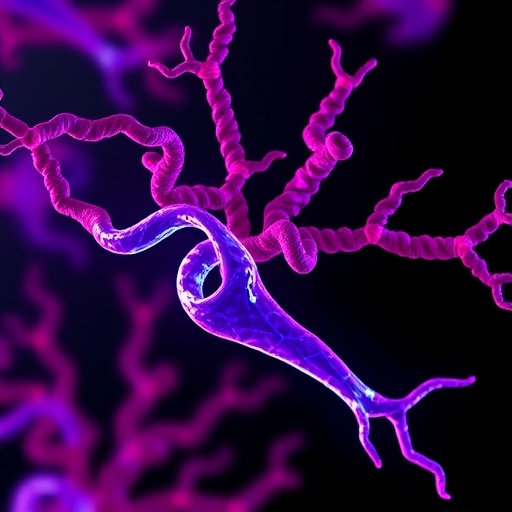In the ever-evolving arena of drug discovery, targeted protein degradation has emerged as a revolutionary strategy to tackle proteins previously deemed “undruggable” by conventional modalities. A new study spearheaded by Chu, Chen, Yang, and colleagues introduces a groundbreaking high-throughput screening platform named DEath FUSion Escaper (DEFUSE), which could dramatically accelerate the identification of small molecules capable of inducing selective protein degradation. This innovative approach holds promise not only for expanding the repertoire of drug targets but also for delivering precision therapeutics against diseases such as cancer.
Traditional drug development often hinges on the ability of small molecules to directly inhibit enzymatic activity or protein-protein interactions. However, many pathogenic proteins lack druggable pockets, rendering them refractory to classical inhibition. The field of targeted protein degradation circumvents this obstacle by co-opting the cell’s intrinsic protein quality control machinery to selectively eliminate target proteins. As such, molecules known as “degraders” recruit E3 ubiquitin ligases to the target protein, triggering ubiquitination and subsequent proteasomal degradation. While the concept is powerful, identifying effective degraders remains a significant bottleneck due to limitations in screening technologies and the structural complexity of induced-proximity interactions.
Addressing these challenges head-on, the DEFUSE platform redefines the screening paradigm by converting protein degradation into a phenotypic readout of cell survival. The technique ingeniously fuses the protein of interest to a rapid-acting, inducible death protein. In cells expressing this fusion construct, degradation of the target protein disrupts the death protein’s function, thereby rescuing the cell from induced apoptosis. Consequently, the survival of cells under selective pressure becomes an unequivocal indicator of effective targeted degradation. This switch from traditional biochemical assays to a survival-based, high-throughput cellular assay enables rapid and sensitive detection of functional degraders.
Applying DEFUSE to the oncoprotein SKP2, the researchers discovered a novel small molecule, SKPer1, that potently and selectively induces degradation of SKP2. SKP2 is a vital component of the SCF (SKP1-CUL1-F-box protein) E3 ligase complex and has been widely implicated in cancer pathogenesis through its regulation of cell cycle progression and degradation of tumor suppressors such as p27Kip1. Overexpression of SKP2 frequently correlates with poor prognosis in multiple malignancies, making it a highly attractive yet elusive therapeutic target. SKPer1’s ability to specifically eliminate SKP2 confirms the power of DEFUSE in unearthing potent molecular glues that prompt simultaneous interaction of SKP2 with the E3 ligase STUB1, culminating in targeted ubiquitination and proteasomal clearance.
Mechanistically, SKPer1 functions as an induced-proximity degrader, a subclass of targeted degraders that act by physically bridging the target protein with an E3 ligase that otherwise does not interact under normal cellular conditions. This strategy not only broadens the range of E3 ligases that can be harnessed for degradation but also exemplifies the subtleties of molecular glue chemistry in drug discovery. The study expands our understanding of induced proximity effects, demonstrating that carefully engineered small molecules can initiate protein-protein interactions previously uncharacterized, thereby reprogramming cellular ubiquitination pathways with high specificity.
The therapeutic implications of SKPer1 were rigorously validated both in vitro and in vivo. In cellular models, SKPer1 treatment led to a marked reduction in SKP2 protein levels accompanied by decreased proliferative capacity specifically in SKP2-expressing cancer cell lines. Importantly, this degradation translated to selective cytotoxicity, highlighting the molecule’s precision and minimal off-target effects. Animal studies corroborated these findings, where SKPer1 administration achieved significant tumor growth suppression with an encouraging safety profile. This preclinical success underscores SKPer1’s potential as a lead candidate for further drug development, offering hope for combating refractory cancers driven by SKP2 dysregulation.
Beyond the discovery of SKPer1, the DEFUSE platform unveiled an additional innovative insight: a ten-amino acid sequence derived from SKP2 can be leveraged as a modular degradation tag. This peptide sequence serves as a versatile handle that, when fused to other proteins, confers susceptibility to the SKPer1-induced degradation machinery. Such a tool represents a powerful new methodology for conditionally controlling protein stability, offering avenues for both basic research applications and therapeutic development, including the design of bespoke protein degradation systems tailored to diverse targets.
The imaging-based nature of DEFUSE is particularly compelling, as it allows rapid visualization and quantification of degradation events through fluorescence microscopy, enabling screens to be conducted efficiently on large chemical libraries. This contrasts with many existing approaches that rely on indirect or low-throughput assays, thus positioning DEFUSE as a scalable solution for accelerated drug discovery pipelines. The high sensitivity and specificity of the system ensure that identified hits are physiologically relevant degraders, increasing the likelihood of downstream translational success.
Furthermore, DEFUSE’s modular design is adaptable to any protein of interest, broadening its applicability across a spectrum of disease-related proteins. By harnessing different death effector domains, the method could be customized to optimize readouts in various cell types or contextual environments, thereby expanding the potential target space for induced-proximity degraders. In essence, DEFUSE represents a bridge between molecular biology innovation and chemical biology screening, providing a transformative toolkit to decode and exploit protein degradation pathways.
The discovery of SKPer1 also highlights the importance of E3 ligase diversity in degrader design. While many prototypical degraders utilize well-characterized E3 ligases such as cereblon or VHL, SKPer1’s recruitment of STUB1 uncovers new molecular relationships and underscores the therapeutic value of targeting underexplored components of the ubiquitin-proteasome system. This diversification could mitigate resistance mechanisms and expand degrader efficacy across different disease contexts.
Importantly, the study also emphasizes the relevance of induced-proximity pharmacology—where the small molecule acts as a molecular matchmaker rather than a conventional active site binder. This paradigm shift challenges traditional medicinal chemistry approaches and calls for a deeper integration of structural biology, proteomics, and chemical design to optimize molecular glue degraders. The findings from DEFUSE and SKPer1 thus provide critical proof-of-concept evidence for this promising therapeutic strategy.
Taken together, this work provides a blueprint for future efforts aiming to explore the vast “degradable” proteome. The convergence of innovative screening technology, mechanistic insights into induced proximity, and tangible therapeutic success propels the field of targeted protein degradation into a new era. As the scientific community continues to dissect the underlying biology and refine the chemical tools, approaches like DEFUSE could become standard in the drug discovery toolbox, accelerating the development of first-in-class therapies against challenging disease targets.
In conclusion, the development of the DEFUSE screening platform and the identification of SKPer1 as a potent degrader of the oncogenic SKP2 exemplify the transformative power of modern protein degradation technologies. By translating biochemical degradation events into a robust cell survival phenotype and harnessing induced-proximity effects, this study illuminates previously inaccessible facets of drug discovery. The integration of these advancements promises to redefine therapeutic intervention strategies for cancer and beyond, heralding a new wave of precision medicines tailored to manipulate the proteome at will.
This pioneering research not only expands the frontiers of targeted degradation but also sets a precedent for future high-throughput approaches that blend biological ingenuity with chemical innovation. As the global community strives to conquer disease at the molecular level, platforms like DEFUSE and discoveries like SKPer1 represent beacon technologies that will shape the landscape of precision oncology and molecular pharmacology for years to come.
Subject of Research: Targeted protein degradation technology and discovery of small-molecule degraders for oncogenic proteins
Article Title: A rapid imaging-based screen for induced-proximity degraders identifies a potent degrader of oncoprotein SKP2
Article References:
Chu, Y., Chen, S., Yang, M. et al. A rapid imaging-based screen for induced-proximity degraders identifies a potent degrader of oncoprotein SKP2. Nat Biotechnol (2025). https://doi.org/10.1038/s41587-025-02793-8
Image Credits: AI Generated
Tags: advancements in screening technologiesDEath FUSion EscaperE3 ubiquitin ligases recruitmenthigh-throughput screening platforminnovative drug development strategiesovercoming undruggable proteinsprecision therapeutics for cancerproteasomal degradation mechanismsselective protein degradationSKP2 oncoprotein degradersmall molecules for drug discoverytargeted protein degradation





